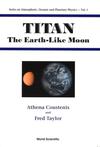提坦
出版时间:1999-12 出版社:东南大学出版社 作者:Taylor, Fred 页数:330
内容概要
This is the first book to deal with Titan, one of the most mysterious bodies in the solar system. The largest satellite of the giant planet Saturn, Titan is itself larger than the planet Mercury, and is unique in being the only known moon with a thick atmosphere. In addition, its atmosphere bears a startling resemblance to the Earth's, but is much colder.The American and European space agencies, NASA and ESA, have recently combined efforts to send a huge robot spacecraft to orbit Saturn and land on Titan. This book provides the background to this, the greatest deep space venture of our time, and sets the scene for what may be found when the spacecraft arrives in 2004.
书籍目录
ProlegomenaChapter 1: Introduction 1.1 Early history 1.2 Titan in mythology 1.3 The 20th century, before Voyager 1.4 Titan in the Space Age 1.5 Sources and Further ReadingChapter 2: Observations of Titan 2.1 Introduction: space exploration of our Solar System 2.2 Space missions to the Saturnian system 2.2.1 Pioneer ll: first to Saturn 2.2.2 The Voyager missions 2.2.3 Results from Voyager: an overview 2.2.4 The Cassini-Huygens mission 2.3 Space observatories 2.3.1 The Hubble Space Telescope (HST) 2.3.2 The Next Generation Space Telescope (NGST) 2.3.3 The infrared space observatory (ISO) 2.4 Ground-based observatories 2.4.1 The Mauna Kea observatories 2.4.2 The European Southern observatories 2.4.3 The IRAM Telescope and Radio Astronomy 2.4.4 The Very Large Array 2.4.5 Other observatories 2.5 Sources and Further ReadingChapter 3: Atmospheric Physics and Thermal Structure 3.1 Physical aspects of a substantial atmosphere 3.1.1 Definitions 3.1.2 Thermal structure and nomenclature 3.1.3 Troposphere 3.1.4 Stratosphere 3.1.5 Mesosphere 3.1.6 Thermosphere 3.1.7 Exosphere 3.2 Atmospheric radiative transfer 3.2.1 Solar radiation 3.2.2 Thermal radiation 3.2.3 Energy balance and surface temperature 3.2.4 Atmospheric temperature profile 3.3 Atmospheric observations 3.3.1 Remote temperature sounding 3.3.2 Vertical resolution 3.4 Measurements of Titan's atmospheric temperature 3.4.1 The lower atmosphere 3.4.2 Energy balance and the temperature profilein the thermosphere 3.4.3 Stellar occultation 3.5 Titan's ionosphere 3.6 Sources and Further ReadingChapter 4: Chemistry and Composition 4.1 Stratospheric composition and variations 4.1.1 Analysis of the Voyager infrared data 4.1.2 Seventeen years after Voyager, the ISO looks at 4.1.3 Ground-based observations of the atmosphere 4.2 Interpreting molecular abundances 4.2.1 Oxygen-bearing molecules: CO, CO2 and H2O 4.2.2 Argon 4.2.3 Deuterium: CH3D and D/H ratio 4.3 Photochemistry 4.3.1 Hydrocarbons 4.3.2 Nitriles 4.3.3 Oxygen compounds 4.3.4 Condensation efficiencies 4.3.5 Aerosol production 4.4 Sources and Further ReadingChapter 5: Aerosols and CondensatesChapter 6: Atmospheric Dynamics and MeteorologyChapter 7: The Surface and Interior of TitanChapter 8: Titan in the solar systemChapter 9: Cassini and Huygens:Orbiting Saturn and Landing on TitanChapter 10: EpilogueReferences and Bibliography
图书封面
评论、评分、阅读与下载
用户评论 (总计0条)
推荐图书
- 家庭法
- 宪法
- 环境法
- Emanuel法律概述
- 联邦证据法规Federal Rules of Evidence
- 宪法,2006案例补充Constitutional Law 2006 Case Supplement
- 国际法2005-2006选择文件International Law 2005-2006 Selected Documents
- 职业责任
- 实现全球经济的可持续社会
- 社会经济民主及世界政府
- 案例举要系列
- 合同法
- 刑法
- CrunchTime系列
- 代理与合伙人
- 案例举要系列
- 审判前的辩护
- 合同法
- 证据的联邦规则,2006法令增补本Federal Rules of Evidence 2006 Statutory Supplement
- 追赶与落后
- 案例举要系列
- 国际法
- 案例举要系列
- 劳动歧视法
- 房地产法
相关图书
- 量子计算与信息概论/INTRODUCTION TO QUANTUM COMPUTATION AND INFORMATION
- 信息、随机及不完整性
- 压铸工艺与模具设计
- 中国文物精华1993
- 中国博物馆 吉林省博物馆
- 水射流切割技术
- 民法
- 宪法学
- 科技法学
- 上大法学评论
- 中国法制史
- 刑法总论
- 技术监督法律教程
- 多元的法律文化
- 地理标志的法律保护研究
- 美国法律史
- 钩针编织案例详解
- 本科教学工作水平评估观测点研究
- 律师执业基本功
- 关于摘要Just Briefs
- 刑事诉讼,2006案例和法令补充Criminal Procedure 2006 Case Supplement
- 法律写作风格指南Guide to Legal Writing Style, 3E
- 刑事诉讼法大全,2006增补版Comprehensive Criminal Procedure 2006 Case Supplement
- 商业组织法的解释与案例
- Emanuel法律概述
